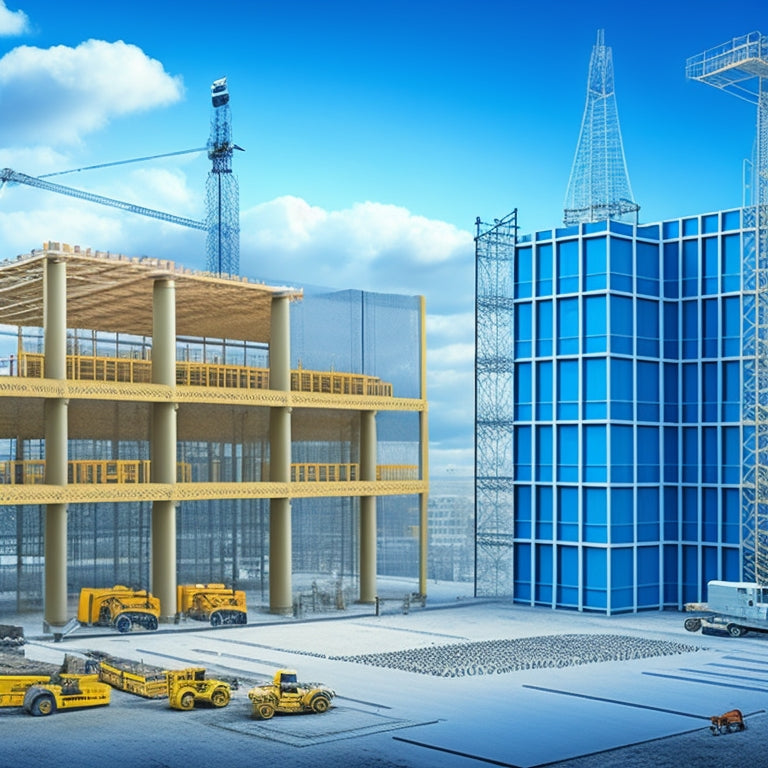
Renovation Timeline Template for Concrete Construction Projects
Share
You'll need a renovation timeline template that breaks down concrete construction projects into manageable phases, ensuring you're on track to meet critical deadlines and stay within budget. Your template should outline the pre-construction planning phase, where you'll spend 2-5 months finalizing project details and assembling your construction team. Next, you'll move on to site preparation and demolition, followed by cinder block foundation work, wall construction and installation, and finally, a thorough final inspection and completion. By following this structured approach, you'll be able to identify potential roadblocks and make adjustments to stay on schedule, and now, you're one step closer to bringing your concrete construction project to life.
Key Takeaways
• Develop a detailed pre-construction plan, including finalizing project details, assembling the team, and establishing a comprehensive budget.
• Ensure compliance with local building codes and regulations throughout the project, including site preparation and demolition.
• Create a concrete construction schedule, including excavation, foundation work, wall construction, and installation, and final inspection.
• Identify and allocate time for potential contingencies, such as weather delays or material shortages, to minimize project timeline disruptions.
• Establish a quality control process to verify task completion, address defects, and ensure a clean and safe site throughout the project.
Pre-Construction Planning Phase
During the pre-construction planning phase, you'll typically spend 2-5 months finalizing project details, securing necessary permits, and assembling your construction team. This phase is vital in setting the stage for a successful project. You'll work closely with architects, engineers, and designers to finalize blueprints, making sure they meet local building codes and regulations.
Budget estimation is a significant aspect of this phase. You'll need to establish an all-encompassing budget that accounts for all aspects of the project, including materials, labor, and contingencies. A well-estimated budget will help you make informed decisions and avoid costly surprises down the line.
Permit acquisition is another key task during this phase. You'll need to obtain the necessary permits and approvals from local authorities before commencing construction. This process can be time-consuming, so it's important to plan ahead and factor in potential delays.
Site Preparation and Demolition
With your pre-construction planning phase complete, you're now ready to mobilize your team and equipment to the construction site, where you'll begin preparing the site and demolishing any existing structures. This phase is critical to guaranteeing a solid foundation for your concrete construction project.
You'll start by implementing soil stabilization techniques to guarantee the ground can support the weight of your structure. This may involve excavating unstable soil, compacting the ground, or using specialized equipment to densify the soil.
Next, you'll develop and execute debris removal strategies to clear the site of any existing structures, rubble, or hazardous materials. This will involve coordinating with local authorities to obtain necessary permits and arranging for responsible disposal of waste materials.
Throughout the site preparation and demolition phase, it's vital to maintain strict quality control measures to guarantee the site is safe, accessible, and ready for the next phase of construction.
Cinder Block Foundation Work
You'll lay the groundwork for your concrete construction project by building a solid cinder block foundation, which involves excavating a trench for the footings, pouring the footings, and constructing the foundation walls. This critical phase requires careful planning and execution to guarantee a stable and durable base for your structure.
When selecting cinder block types, consider factors such as compressive strength, density, and moisture resistance. You may opt for standard gray blocks or specialized blocks with added insulation properties for improved energy efficiency.
Here's a breakdown of the cinder block foundation work process:
| Task | Duration |
| Excavate trench for footings | 2-3 days |
| Pour footings | 1-2 days |
| Construct foundation walls | 5-7 days |
| Install foundation insulation | 1-2 days |
| Backfill and compact soil | 2-3 days |
Remember to consult local building codes and regulations, and consider consulting with a structural engineer or experienced contractor to guarantee your foundation meets the necessary standards.
Wall Construction and Installation
Your concrete construction project's walls take shape as you construct and install wall panels, guaranteeing a sturdy framework that can support the weight of the building and withstand environmental forces.
You'll need to decide on the type of walls that suit your project, such as load-bearing walls, non-load bearing walls, or shear walls. Each type has its unique characteristics, advantages, and installation requirements.
When it comes to insulation, you'll need to choose an effective method that suits your wall type and climate. Common insulation methods include batt insulation, spray foam insulation, and rigid foam insulation. Proper insulation is vital to maintain a comfortable indoor temperature, reduce energy consumption, and prevent moisture damage. Make sure that your insulation method complies with local building codes and regulations.
During wall construction and installation, it's important to follow the project's architectural plans and specifications. Verify that the wall panels are correctly aligned, securely fastened, and meet the required building codes. This stage requires attention to detail, precision, and quality control to guarantee the structural integrity of your concrete construction project.
Final Inspection and Completion
After completing the wall construction and installation, conduct a thorough final inspection to confirm all aspects of the concrete construction project meet the required building codes, specifications, and quality standards.
This final walkthrough confirms that all defects, deficiencies, or omissions are identified and addressed before project completion.
During the final inspection, review your project checklist to verify that all tasks have been completed satisfactorily.
Pay attention to details such as:
-
All concrete work is completed, and finishes meet the specified requirements
-
All electrical, plumbing, and HVAC installations are functional and meet code requirements
-
All doors, windows, and hardware are properly installed and functional
- The site is clean, and all debris has been removed, confirming a safe and hazard-free environment.
Frequently Asked Questions
What Is the Ideal Team Size for a Concrete Construction Project?
When it comes to determining the ideal team size for your concrete construction project, you'll want to evaluate the team roles required for success.
A smaller team can lead to clearer project communication, but may lack specialized skills.
A larger team offers more expertise, but can lead to communication breakdowns.
You'll need to strike a balance, ensuring each role is covered without overwhelming the project with too many stakeholders.
How Do I Handle Unexpected Changes in Project Scope?
When handling unexpected changes in project scope, you'll need to act quickly to minimize delays and cost overruns.
First, assess the impact of the change on your project schedule and budget.
Then, document the change request and obtain stakeholder approval.
Next, issue a change order outlining the scope, cost, and timeline adjustments.
Finally, update your scope management plan to reflect the changes and guarantee all team members are aligned.
What Is the Best Way to Document Project Progress and Milestones?
You need a systematic approach to document project progress and milestones.
For effective project tracking, maintain a centralized log to record daily activities, updates, and changes.
Implement milestone reporting by scheduling regular check-ins to review accomplishments and upcoming tasks.
This structured approach guarantees you're always aware of your project's status, enabling data-driven decisions and proactive issue resolution.
Can I Customize the Renovation Timeline Template for My Project?
You're the master chef in your project kitchen, and the renovation timeline template is your recipe for success.
Can you customize it to suit your project's unique flavors? Absolutely! You can tweak the template features to fit your project flexibility, adjusting timelines, and milestones to guarantee a perfect blend of tasks and deadlines.
With a few clicks, you'll be whipping up a tailored project plan that's as unique as your construction project.
How Do I Ensure Compliance With Local Building Codes and Regulations?
To guarantee compliance with local building codes and regulations, you'll need to secure necessary building permits and pass code inspections.
Start by researching local ordinances and identifying required permits. Then, submit your plans and wait for approval.
During construction, schedule inspections with local authorities to verify compliance.
Keep records of permits, inspections, and approvals to avoid potential issues and guarantee your project meets regulatory standards.
Conclusion
As you near the finish line, your concrete construction project's renovation timeline is like a puzzle coming together, each phase fitting seamlessly into place.
With a solid plan, you've navigated the twists and turns of pre-construction, site prep, foundation work, wall construction, and final inspection.
Now, stand back and admire your masterpiece - a sturdy, concrete structure that's a demonstration of your meticulous planning and execution.
The end result is a symphony of concrete, steel, and sweat equity.
Related Posts
-

7 Patio Safety Tips for DIY Renovation Projects
As you begin your DIY patio renovation project, prioritize safety by evaluating the worksite for tripping hazards and...
-

3 Best Block Wall Renovation Checklists for DIYers
When tackling a block wall renovation, you'll need three essential checklists to guarantee a successful DIY project. ...
-

Why Invest in Dedicated Tool Storage for Renovation
You invest considerably in tools and equipment for your renovation projects, making dedicated storage systems essenti...


